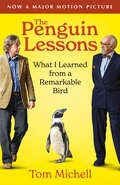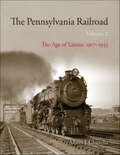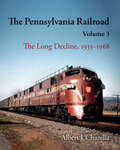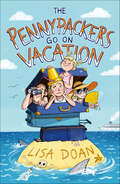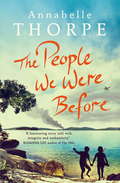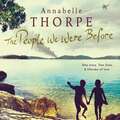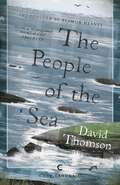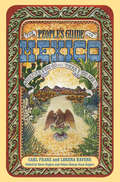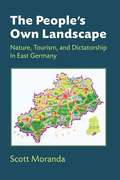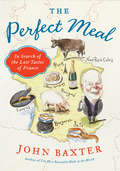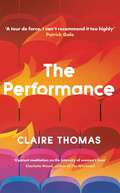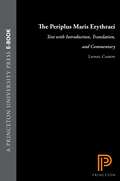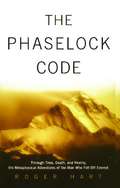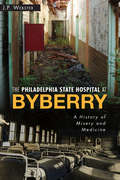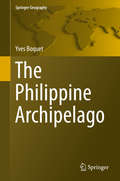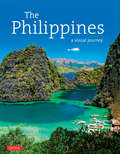- Table View
- List View
The Penguin Atlas of Modern History (to #1815)
by Colin McevedyColin McEvedy has compiled an absorbing source of reference to the major developments of modern history from 1483 to 1815.
The Penguin Atlas of North American History to 1870
by Colin McevedyThis is a reference to the major developments of North American history from pre-human settlement to the American Civil War and more recent changes. Maps and commentary look at
The Penguin Lessons: What I Learned from a Remarkable Bird
by Tom MichellNOW A MAJOR MOTION PICTURE • The extraordinary and inspiring true story about the surprising bond between a young teacher and the small penguin he rescued&“The Penguin Lessons teaches an important truth: that a single act of compassion can be repaid a thousand-fold.&”—Sy Montgomery, author of the National Book Award finalist The Soul of an OctopusIn 1975, twenty-three-year-old Englishman Tom Michell follows his wanderlust to Argentina, where he becomes assistant master at a prestigious boarding school. But Michell&’s adventures really begin when, on a weekend in Uruguay, he rescues a penguin covered in oil from an ocean spill, cleans the bird up, and attempts to return him to the sea. The penguin refuses to leave his rescuer&’s side. &“That was the moment at which he became my penguin, and whatever the future held, we&’d face it together,&” says Michell in this charming memoir.Michell names the penguin Juan Salvador (&“John Saved&”), but Juan Salvador, as it turns out, is the one who saves Michell.After Michell smuggles the bird back to Argentina and into his campus apartment, word spreads about the young Englishman&’s unusual roommate. Juan Salvador is suddenly the center of attention—as mascot of the rugby team, confidant to the dorm housekeeper, co-host of Michell&’s parties, and an unprecedented swimming coach to a shy boy. Even through the collapse of the Perónist government and amid the country&’s economic and political strife, Juan Salvador brings joy to everyone around him—especially Michell, who considers the affectionate animal a compadre and kindred spirit.Witty and heartwarming, The Penguin Lessons is a classic in the making, a story that is both absurd and wonderful, exactly like Juan Salvador.
The Pennsylvania Railroad, Volume 2: The Age of Limits, 1917–1933 (Railroads Past and Present)
by Albert J. ChurellaBy 1933, the Pennsylvania Railroad had been in existence for nearly ninety years. During this time, it had grown from a small line, struggling to build west from the state capital in Harrisburg, to the dominant transportation company in the United States. In Volume 2 of The Pennsylvania Railroad, Albert J. Churella continues his history of this giant of American transportation. At the beginning of the twentieth century, the Pennsylvania Railroad was the world's largest business corporation and the nation's most important railroad. By 1917, the Pennsylvania Railroad, like the nation itself, was confronting a very different world. The war that had consumed Europe since 1914 was about to engulf the United States. Amid unprecedented demand for transportation, the federal government undertook the management of the railroads, while new labor policies and new regulatory initiatives, coupled with a postwar recession, would challenge the company like never before. Only time would tell whether the years that followed would signal a new beginning for the Pennsylvania Railroad or the beginning of the end. The Pennsylvania Railroad: The Age of Limits, 1917–1933,represents an unparalleled look at the history, the personalities, and the technologies of this iconic American company in a period that marked the shift from building an empire to exploring the limits of their power.
The Pennsylvania Railroad: The Long Decline, 1933–1968 (Railroads Past and Present)
by Albert J. ChurellaThe final volume of Albert J. Churella's landmark series, The Pennsylvania Railroad, concludes the story of the iconic transportation company, covering its long decline from the 1930s to its merger with the New York Central Railroad in 1968.Despite some parallels with World War I, the experience of World War II had a substantially different impact on the Pennsylvania Railroad. The introduction of new technologies, personnel, and commuter routes had significant effects on this giant of American transportation. The recession of 1958 sparked a period of decline from which it and many other railroads struggled to fully recover.The Pennsylvania Railroad: The Long Decline, 1933-1968 provides an unparalleled look at the final years of this legendary company, which in its prime was the largest corporation in the world, with a budget second only to that of the US federal government.
The Pennypackers Go on Vacation
by Lisa DoanThe cheapest family in the world decides to go on an off-brand cruise in this wacky mystery/adventure story.Mr. Pennypacker is cheap. But Mrs. Pennypacker has wrestled money for a vacation from his tightfisted grip, and the family is on their way to a Disney cruise. Charlie Pennypacker is thrilled to be going somewhere—an eleven story luxury cruise liner, 212-foot water slide, and an all-night buffet awaits! So Charlie thinks. The vacation is actually a Wisney cruise, which means a dilapidated fishing boat, fake Disney characters, no water slide, eggs for every meal, and his enemy Gunter Hwang, who has been brought along for thirty dollars a day. On top of that, the captain is on the run from sinister men in dark suits. It's a Caribbean game of cat and mouse involving wits, interrogations, a hidden room, races against time, and clever deceptions. As Mr. Pennypacker would say, you can't get this kind of adventure on those other overpriced cruises.
The People We Were Before
by Annabelle ThorpeIf war is madness, how can love survive?Yugoslavia, summer 1979. A new village. A new life. But eight-year-old Miro knows the real reason why his family moved from the inland city of Knin to the sunkissed village of Ljeta on the Dalmatian Coast, a tragedy he tries desperately to forget. The Ljeta years are happy ones, though, and when he marries his childhood sweetheart, and they have a baby daughter, it seems as though life is perfect. However, storm clouds are gathering above Yugoslavia.War breaks out, and one split-second decision destroys the life Miro has managed to build. Driven by anger and grief, he flees to Dubrovnik, plunging himself into the hard-bitten world of international war reporters.There begins a journey that will take him ever deeper into danger: from Dubrovnik, to Sarajevo, to the worst atrocities of war-torn Bosnia, Miro realises that even if he survives, there can be no way back to his earlier life. The war will change him, and everyone he loves, forever.(P)2016 Headline Digital
The People We Were Before
by Annabelle ThorpeIf war is madness, how can love survive?Growing up in the borderlands between Croatia and Serbia, Miro's blissful childhood is shattered when his best friend is horribly wounded by a land-mine, a legacy of conflicts gone by.Moving to the Dalmatian coast, where his parents start a small hotel, he thinks he has left this all behind - he falls in love and starts a family with his childhood sweetheart, Dina. But as his country descends into another devastating war, one split-second decision that causes his daughter's death destroys the life he has managed to build.Rejected by his grieving wife, Miro takes a job as a cameraman with a news channel and is plunged into the hard-bitten black-humoured world of the international war reporters. He even finds some solace in an affair with Marian, a BBC journalist, but as he feels the war changing him and his loved ones beyond all recognition, he must struggle to keep his relationship, and his soul, intact.(P)2016 WF Howes Ltd
The People of the Sea: Celtic Tales of the Seal-Folk (Canons #8)
by David Thomson&“Readers will be carried away on successive waves of pleasure [and] irresistible holistic beauty&” in this journey to uncover myths of Selchies (Seamus Heaney, from the introduction). When author David Thomson travelled across the coasts of Scotland and Ireland to seek out the legend of the selchies—mythological creatures who transform from seals into humans—a magical world emerged before him. Thomson was enchanted by tales of men rescued by seals in stormy seas, and others who took seal-women for their wives and had their children suckled by seal-mothers. The People of the Sea is Thomson&’s poetic record of his journey into this world, and his encounters with people whose connection to the sea and its fertile lore runs deep. Winner of the McVitie Prize for his memoir Nairn in Darkness and Light, David Thomson offers &“a splendid resurrection of a life that has almost vanished.&” Timeless and haunting, The People of the Sea retains its spellbinding charm and brings to life the enchanting stories of these mysterious creatures of Celtic folklore (Daily Telegraph, UK).&“I know of few books which so ably open a window on the Gaelic scene today or which so faithfully reflect the mind, vigour and courtesy of its people…Pounds on the imagination like surf on a reef&”—Observer, UK
The People's Guide to Mexico
by Carl Franz Lorena HavensFor more than 40 years, hundreds of thousands of readers have agreed: This is the classic guide to "living, traveling, and taking things as they come" in Mexico. Now in its updated fourteenth edition, The People's Guide to Mexico still offers the ideal combination of basic travel information, entertaining stories, and friendly guidance about everything from driving in Mexico City to bartering at the local mercado to hanging a hammock. Features include:
The People's Own Landscape: Nature, Tourism, And Dictatorship In East Germany
by Scott MorandaEast Germany’s Socialist Unity Party aimed to placate a public well aware of the higher standards of living enjoyed elsewhere by encouraging them to participate in outdoor activities and take vacations in the countryside. Scott Moranda considers East Germany’s rural landscapes from the perspective of both technical experts (landscape architects, biologists, and physicians) who hoped to dictate how vacationers interacted with nature, and the vacationers themselves, whose outdoor experience shaped their understanding of environmental change. As authorities eliminated traditional tourist and nature conservation organizations, dissident conservationists demanded better protection of natural spaces. At the same time, many East Germans shared their government’s expectations for economic development that had real consequences for the land. By the 1980s, environmentalists saw themselves as outsiders struggling against the state and a public that had embraced mainstream ideas about limitless economic growth and material pleasures.
The Peranakan Chinese Home
by A. Chester Ong Ronald G. KnappDiscover the rarified Peranakan (native-born Chinese of Southeast Asia) aesthetics that are today highly sought-after for their beauty: distinctive furniture and ceramics, textiles and jewelry, and many other art objects. Peranakan Chinese Home displays these extraordinary objects, visible markers of a highly developed culture.The broad range of beautiful objects which the Peranakan Chinese created and enjoyed in their daily lives is astounding. Each chapter in Peranakan Chinese Home focuses on a different area and presents objects used or found in those spaces. Each piece is described in the context of their utility as household objects, as part of periodic celebrations to mark the Chinese New Year and other holidays, or in important life passage rituals relating to ancestor worship, birth, marriage, mourning and burial. The meaning of the rich symbolic and ornamental motifs found on the objects is discussed in detail and key differences are highlighted between Peranakan objects and similar ones found in China.A fascinating mix of Chinese, European and Southeast Asian influences, the distinctly Peranakan identity of a people and their culture is beautifully portrayed through objects and archival photographs in this lovely and exotic book.
The Peranakan Chinese Home
by A. Chester Ong Ronald G. KnappDiscover the rarified Peranakan (native-born Chinese of Southeast Asia) aesthetics that are today highly sought-after for their beauty: distinctive furniture and ceramics, textiles and jewelry, and many other art objects. Peranakan Chinese Home displays these extraordinary objects, visible markers of a highly developed culture.The broad range of beautiful objects which the Peranakan Chinese created and enjoyed in their daily lives is astounding. Each chapter in Peranakan Chinese Home focuses on a different area and presents objects used or found in those spaces. Each piece is described in the context of their utility as household objects, as part of periodic celebrations to mark the Chinese New Year and other holidays, or in important life passage rituals relating to ancestor worship, birth, marriage, mourning and burial. The meaning of the rich symbolic and ornamental motifs found on the objects is discussed in detail and key differences are highlighted between Peranakan objects and similar ones found in China.A fascinating mix of Chinese, European and Southeast Asian influences, the distinctly Peranakan identity of a people and their culture is beautifully portrayed through objects and archival photographs in this lovely and exotic book.
The Perfect Man: Let the #1 bestselling author take you on a life-changing journey …
by Sheila O'FlanaganA captivating novel about family ties, romance and leaving the past behind - THE PERFECT MAN by No. 1 bestselling author Sheila O'Flangan. A perfect read for fans of Fern Britton and Veronica Henry.Brit doesn't believe in love. One painful mistake was all it took. So she's as surprised as anyone when her novel THE PERFECT MAN becomes a huge bestseller - how did she manage to write so convincingly about love if she really thinks it's a myth?Heartbreak has never stopped her sister Mia from being a hopeless romantic. She can't be with the love of her life, but she's never stopped hoping. They both need to let go of the past to stand a chance of being happy in the future. Could a Caribbean cruise be just what they need to open their hearts?What readers are saying about The Perfect Man:'A soul-bearing story. Beautifully written as always. Two very different sisters at similar points in their lives' Goodreads reviewer, 5 stars'A great read. The characters really came to life and I enjoyed it from start to finish. Excellent!' Amazon reviewer, 5 stars'I absolutely lovedit - the cover, the writing, the characters - it was all fabulous. It reads like a dream and you could imagine all of the beautiful locations described. I wholly recommend it!' Amazon reviewer, 5 stars
The Perfect Man: Let the #1 bestselling author take you on a life-changing journey …
by Sheila O'FlanaganA captivating novel about family ties, romance and leaving the past behind - THE PERFECT MAN by No. 1 bestselling author Sheila O'Flangan. A perfect read for fans of Fern Britton and Veronica Henry. Brit doesn't believe in love. One painful mistake was all it took. So she's as surprised as anyone when her novel THE PERFECT MAN becomes a huge bestseller - how did she manage to write so convincingly about love if she really thinks it's a myth?Heartbreak has never stopped her sister Mia from being a hopeless romantic. She can't be with the love of her life, but she's never stopped hoping. They both need to let go of the past to stand a chance of being happy in the future. Could a Caribbean cruise be just what they need to open their hearts?What readers are saying about The Perfect Man: 'A soul-bearing story. Beautifully written as always. Two very different sisters at similar points in their lives' Goodreads reviewer, 5 stars'A great read. The characters really came to life and I enjoyed it from start to finish. Excellent!' Amazon reviewer, 5 stars'I absolutely loved it - the cover, the writing, the characters - it was all fabulous. It reads like a dream and you could imagine all of the beautiful locations described. I wholly recommend it!' Amazon reviewer, 5 stars
The Perfect Man: Let the #1 bestselling author take you on a life-changing journey …
by Sheila O'FlanaganA captivating novel about family ties, romance and leaving the past behind - THE PERFECT MAN by No. 1 bestselling author Sheila O'Flangan. A perfect read for fans of Liane Moriarty and Kathryn Hughes. Brit doesn't believe in love. One painful mistake was all it took. So she's as surprised as anyone when her novel THE PERFECT MAN becomes a huge bestseller - how did she manage to write so convincingly about love if she really thinks it's a myth?Heartbreak has never stopped her sister Mia from being a hopeless romantic. She can't be with the love of her life, but she's never stopped hoping. They both need to let go of the past to stand a chance of being happy in the future. Could a Caribbean cruise be just what they need to open their hearts?(P)Oakhill Publishing Group Ltd 2012
The Perfect Meal
by John BaxterPart Grand Tour of France, part history of French cuisine: an irresistible journey, from Paris to Provence, to find the perfect meal An expat Paris resident for more than twenty years, John Baxter began noticing an alarming trend: just as species of plants and animals are rapidly facing extinction globally, so too are the traditional ingredients and techniques of classic French cooking and eating. Indeed, he worried that the soul of the world’s most revered national cuisine is in danger of disappearing, as centuries-old ways of cooking, preparation, and farming wither away. Spurred to action, Baxter set off across the country on an unforgettable quest to taste the last great French dishes before they disappear forever—from Paris’s surviving haute cuisine establishments to the tiny local restaurants that still serve the remarkable regional dishes of Provence, Normandy, Cote d’Azur, and more.
The Perfect Pint: A Beer Lover's Handbook
by Andy HamiltonWith over 300 breweries opening in the UK every single year, why not swap 'a pint of the usual' for something more unusual? Andy Hamilton has tried hundreds, if not thousands, of pints from the avalanche of new flavours now available and has convinced commercial, craft and home brewers across Britain to share some of their top secret best recipes. - Learn how to taste - and talk - beer like the professionals.- Drink some of the finest ales made in Britain.- Find out the secrets of a perfect porter, an irresistible IPA, a super stout or that marvellous mild. An in-depth tour of beer and brewing, this is the essential companion for anyone who enjoys a decent British pint.Cheers!
The Performance: A Novel
by Claire Thomas'Quietly transformational'The Times 'A tour de force... I can't recommend this too highly'Patrick Gale'Innovative... an original, at-a-sitting read'Daily Mail'A potent meditation on the intensity of women's lives'Charlotte Wood, author of The Weekend'A miracle... Engaging and evocative'Washington Post'I loved and admired The Performance... Unmissable'Emma Stonex, author of The Lamplighters'Lively and intimate... The way Thomas plays with the reader is a sort of genius'Guardian'Thomas writes these women with such wisdom and compassion, that by the end we are all transformed'Claire Fuller, author of Unsettled Ground The false cold of the theatre makes it hard to imagine the heavy wind outside in the real world, the ash air pressing onto the city from the nearby hills where bushfires are taking hold.The house lights lower.The auditorium feels hopeful in the darkness.As bushfires rage outside the city, three women watch a performance of a Beckett play.Margot is a successful professor, preoccupied by her fraught relationship with her ailing husband. Ivy is a philanthropist with a troubled past, distracted by the snoring man beside her. Summer is a young theatre usher, anxious about the safety of her girlfriend in the fire zone.As the performance unfolds, so does each woman's story. By the time the curtain falls, they will all have a new understanding of the world beyond the stage.
The Periplus Maris Erythraei: Text with Introduction, Translation, and Commentary
by Lionel CassonThe Periplus Maris Erythraei, "Circumnavigation of the Red Sea," is the single most important source of information for ancient Rome's maritime trade in these waters (i.e., the Red Sea, Gulf of Aden, and western Indian Ocean). Written in the first century A.D. by a Greek merchant or skipper, it is a short manual for the traders who sailed from the Red Sea ports of Roman Egypt to buy and sell in the various ports along the coast of eastern Africa, southern Arabia, and western India. This edition, in many ways the culmination of a lifetime of study devoted to Rome's merchant marine and her trade with the east, provides an improved text of the Periplus, along with a lucid and reliable translation, a comprehensive general commentary that treats in particular the numerous obscure place-names and technical terms that occur, and a technical commentary that deals with grammatical, lexicographical, and textual matters for readers competent in Greek. An extensive introduction places the Periplus in its historical context.
The Phaselock Code: Through Time, Death and Reality -- The Metaphysical Adventures of Man
by Roger HartONE MAN'S REMARKABLE SEARCH FOR THE ULTIMATE TRUTHS OF OUR WORLD. For Professor Roger Hart, life truly began after he almost lost his -- in a horrific fall off the slopes of Mount Everest that he miraculously survived. This near-death experience sparked a desire in him to devote his studies to the very nature of human consciousness, in order to unlock the code of reality that binds our world. On an adventure of discovery that would take him around the world, Hart would experience life-altering transcendental events in Tibet, Morocco, and Tierra del Fuego -- opening the door to a true understanding of the nature of man. In this groundbreaking volume, he explores the participation of consciousness in the creation of reality, challenging the traditional scientific view of time, space, and objectivity -- and describing in detail his own metaphysical journey, which has involved synchronicity, precognition, and telekinesis. It is an exploration of the very things that make us human -- and a quest that touches upon the meaning of life itself.
The Philadelphia Chef's Table: Extraordinary Recipes From The City of Brotherly Love (Chef's Table)
by April White Adam EraceThe second edition of The Philadelphia Chef's Table captures what is a vibrant moment in Philadelphia&’s dining scene through recipes from and conversations with more than fifty of the city&’s most influential and well-known chefs. Philadelphia is a thriving foodie town and Philly food devotees are always hungry for more wonderful choices. With this book you can recreate your favorite dishes at home! Come celebrate the tastes of new tastes of Philadelphia.
The Philadelphia State Hospital at Byberry: A History of Misery and Medicine (Landmarks Ser.)
by John Paul WebsterThis account of the infamous asylum is “an excellent record of greed and corruption, but it is also a powerful testimonial to compassion and kindness” (Hidden City).The Quaker City and its hospitals were pioneers in the field of mental health. Yet by the end of the nineteenth century, its institutions were crowded and patients lived in shocking conditions. The mentally ill were quartered with the dangerously criminal. By 1906, the city had purchased a vast acreage of farmland incorporated into the city, and the Philadelphia Hospital dubbed its new venture Byberry City Farms. From the start, its history was riddled with corruption and committees, investigations and inquests, appropriations and abuse. Yet it is also a story of reform and redemption, of heroes and human dignity—many dedicated staff members did their best to help patients whose mental illnesses were little understood and were stigmatized by society.“The closed hospital’s almost forgotten story intrigued him immediately and then became his passion . . . Webster tells the hospital’s 100-year story in a brisk, easy-to-read style, and the book is illustrated with 75 photographs from the Historical Society of Pennsylvania, Temple University Urban Archives, the Pennsylvania State Archives, the Athenaeum of Philadelphia, PhillyHistory.org and friends.” —Northeast Times“Webster . . . wrote his book because of his fascination with an abandoned building he discovered in 2002. He wanted to tell the story of Byberry, one he believes many people do not fully understand.” —Philadelphia Neighborhoods
The Philippine Archipelago
by Yves BoquetThis book presents an updated view of the Philippines, focusing on thematic issues rather than a description region by region. Topics include typhoons, population growth, economic difficulties, agrarian reform, migration as an economic strategy, the growth of Manila, the Muslim question in Mindanao, the South China Sea tensions with China and the challenges of risk, vulnerability and sustainable development.
The Philippines: A Visual Journey
by Elizabeth V. ReyesThis beautifully photographed travel pictorial captures the people, art, architecture, food and landscapes of the Philippines.The Philippine Archipelago with its 7,100 islands is culturally diverse and unique in Southeast Asia, and renowned for the splendor of its coastal beaches and terraced mountains. Seventy million Filipinos have been nurtured by both tropical environment and unique historical development-through 300 years of Spanish Chistianization and 40 years of American modernization-and have emerged as an attractive blend of East and West, soul and style. The island country is perhaps best known for the friendliness of its people and their natural sense of song, dance and hospitality. The archipelago is also called "Pearl of the Orient".With over 150 photographs and a detailed map, The Philippines: A Visual Journey is an essential book for expats or tourists traveling to the Philippines.


